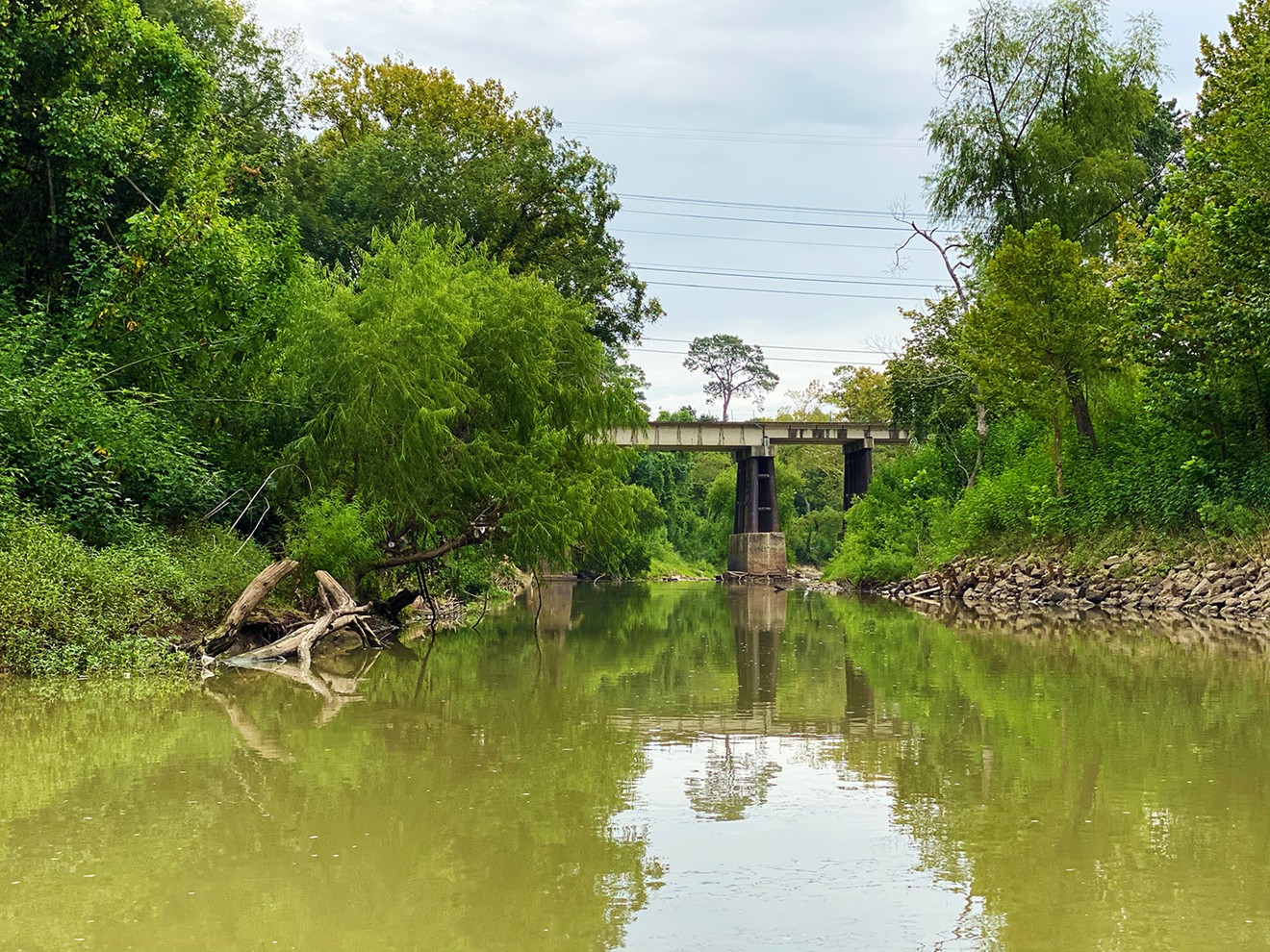This is part four of an ongoing series of posts about my purchase of a canoe during the pandemic.
It was a beautiful, if warm, late Saturday morning and I was standing knee deep in Buffalo Bayou. Above me, cars were whizzing by on the West Loop with no idea that beneath their tires was a desperate man and his wife just trying to get home, dragging a battered canoe against a current that was far more formidable than we had been warned.
Let me take a step back.
Up until this point, my recent canoeing experience had been on lakes. Sure, as a kid, I braved the waters of the Guadalupe, but that was with my parents and I was a child. In the past few months since acquiring this 15-foot Old Town canoe on Facebook Marketplace, I (and my wife) had stuck mostly with places like Raven Lake in Huntsville State Park and the north fork of Lake Conroe. We thought we were ready for more.
Having seen many people canoeing down Buffalo Bayou — kids even! — and having gone on a boat trip with the Buffalo Bayou Partnership down the east end toward the Ship Channel a number of years ago, it seemed like something that any good Houstonian should do. There's a place to put in right at the Loop and Woodway. From there, it's a fascinating ride downstream towards downtown through Memorial Park, the Houston Arboretum and River Oaks. Go far enough and you get the Buffalo Bayou Park with magnificent views of the skyline.
I began to do some research on what to expect. The reviews were positive and reassuring. "Easy," one said. "Nice and slow," another quipped. And there were at least a couple who suggested it was possible to paddle a little ways downstream and then return to your launch point. We understood that with rivers and streams you typically need an exit point downstream where you have to be ferried back to the start. But, this is a slough, a bayou, no problem. And we hadn't had any significant rain in a few weeks.
Well, whoever that person is, they lie.
All journeys begin with a single step and, in this case, with a giant crashing thud into the water. The put in point, while well heeled and in good shape, didn't exactly give you a gentle slope or ramp to put the boat in. The choices were a three-foot drop from a concrete embankment or a climb over a small hill and a steep muddy downslope to the water. We chose the former, attempting the tried and true 1-2-3-go method, which failed spectacularly.
I will stop for a moment here to say that I had the good sense to grab one of the roof tie downs and attach it to the bow of the canoe as a tie line. Had I not done this, well, let's just say this may have been my last canoe column for a while.
Anyway, the canoe tipped in sideways, water pouring in over the side. Stupidly, we left the life jackets in the boat and one began slowing drifting downstream, a bright orange spot in otherwise dense brown water floating away ever so slowly.
We managed to pull the canoe around the corner as we scrambled over the slippery hill. We were able to dump out most of the water and squeeze in. Were we crazy to continue? Well, at the very least, we had to retrieve that damn life preserver. So, off we went.
It should be noted that the ground in and just around the bayou is actually pretty solid even when muddy. We fully expected to sink into the soft quagmire, fearing we might discover Houston's pocket of quicksand that haunted me as a child from all those movies that inexplicably used that as a horror device. Fortunately, the red clay of Houston's soggy swamp bottom keeps the sinkage to a minimum.
At first, it was a fairly easy paddle. We snatched up the floatation device from where it was snagged in a tangle of fallen tree detritus and the gentle current moved us along steep banks with buildings and wildlife seemingly coexisting easily. Huge water birds stared at us as we passed and high-end apartments with balconies overlooking the water lined the landscape. It was all quite peaceful.
It was then that we began to wonder: Can we actually paddle back? I was confident this would be no problem. We spun the boat around and tested my theory. It required a little more effort than moving downstream, but it wasn't bad at all. On we went.
We were both pretty excited to see the banks of the arboretum. Both of us enjoy taking walks there and a fresh perspective seemed really interesting. As we slowly drifted toward the West Loop, we were thoroughly enjoying ourselves.
It was when we passed under the freeway bridge that I began to silently feel concern for our return trip. The water was not what you would call "rapids" per se, but it certainly wasn't a slough either. We found ourselves having to quickly navigate past exposed rebar and tree trunks sitting just beneath the surface. We banged into a couple things — what, I cannot venture to guess — as we were thrust through to the other side of the bridge.
There was a moment of quiet acknowledgement that perhaps this might be more difficult than we expected. But, I expressed continued confidence to my skeptical and clearly much smarter wife as we pressed on.
Indeed, the area near the arboretum as we entered Memorial Park was spectacular. Heavily overgrown banks, beautiful flowers and plants lining both sides of the bayou and all manner of birds were visible as we moved along. It really is a completely different way to look at the city.
I recalled the boat trip I took, working as a photographer for the University of Houston creative writing department as they ferried a group of students through the east end, with its heavy industry and literal mountains of recycled metal along the shores, and downtown, skyscrapers towering above in the autumn sun. Seeing the city from down in the water was a remarkable experience.
This canoe trip was feeling quite the same. Then we reached the railroad tracks.
We were familiar with the trains that ran along the east side of the arboretum, bisecting Memorial Park. And it was fascinating to see it (and a passing train) while floating. But as we peered ahead, we noticed one side of the waterway under the bridge was nearly completely blocked with trees, vegetation, old shopping carts, shoes and bags full of God knows what. We paddled to the open side and were swept quite quickly underneath, smacking into a tree that was barely poking above the surface.
It was at this point we knew we were in trouble and we began to consider our options. Should we just continue downtown and call an Uber to get back to the landing spot? But we didn't bring any masks. And we don't even know what is ahead of us or how long it will take. Why the hell did we decide, for the first time in our collective history, to do a workout that morning that consisted of nothing but arms and shoulders? Would we even survive this?
My wife, ever the voice of reason, said we needed to turn around. Going forward, there were just too many variables we could not predict. Arduous as it might be, going back was the only choice at this point and we immediately committed ourselves to this course of action. Good thing too, because it got weird.
First, there was the issue of getting past this train bridge. Genius that I am, I decided we could get up enough momentum to overcome the rapid current coming directly at us. We tried this exactly three times with the same result, as you might imagine.
On the final try, my wife, who had frantically put her prescription sunglasses in the backpack she strapped tightly to her body in case of an accident minutes earlier, started pointing with her oar. "If we fall in, swim that way!"
I, only worried about this failure of an effort to traverse waters we had no business paddling against in the first place, was simply yelling, "PADDLE, PADDLE, PADDLE!"
Huffing and puffing, we pulled over to the far bank and decided this wasn't going to work. "It's OK," I told my wife. "I live here now."
And then something came over her. This woman whose greatest fear before today was literally having a single drop of bayou water touch her skin, hopped out and began exploring. She was like Magellan or that guy who discovered the Amazon.
She climbed up over a small embankment and yelled back that there wasn't much room, but we could probably carry the canoe along a small trail, past the bridge and safely beyond the rapids. She was right. It would be tough, but we could do it. Minutes later, we were scampering along a slippery bank with an 80-pound canoe filled with life jackets, oars and an ice chest full of drinks left ver from simpler times. A passing boat with two young women stared at us uneasily for a moment and then paddled faster. I couldn't blame them.
Miraculously, we made it and were back on calmer water, the fear of snakes and swamp monsters behind us, but our toils, sadly, weren't over. We had to get out two more times, the last one the aforementioned trek underneath the freeway. That one required being actually in the water. And, if I'm being totally honest, it was nasty. Not because the water seemed dirty — it didn't surprisingly — but because of all the crap people had thrown in it.
Buffalo Bayou really is the repository for our discarded refuse and it's utterly disgusting. This is the state that came up with Don't Mess With Texas, but if you wanted to see just how much we ignore that sentiment, take a look at the trash in and around our bayou systems.
Anyway, it was at this point we both got out and dragged the canoe across some shallow shoals and rocks before finally emerging back into the bayou that was so inaccurately described to us online — a slow, pleasant paddle. Another 20 minutes or so and we were back where we started several hours earlier, having passed dozens of happy canoeists padding downstream on their way to a planned exit at the Sabine Street Bridge. What a novel idea.
We pulled the canoe out of the water and over that slippery hill. On the other side was a man, probably in his 30s with an inflatable kayak getting ready to head out. My wife, probably needing the catharsis, launched into a brief but detailed description of our harrowing journey. The man smiled. "I wondered why you were taking your canoe out here," he said. "I'm glad you made it."
You may now wonder, would we ever do this again? The answer is complicated.
I have already made my intentions to float the bayou again known. In fact, if not for a few days of heavy rain a couple weeks ago, my friend Dat and I would have already done it. My wife, on the other hand, is dubious. She wants the experience, but I'm not sure she is ready to commit to any interaction with Buffalo Bayou anytime soon, even if we only paddled downstream this time.
In the end, we learned something, a number of things actually. Most importantly, we tested our mettle as intrepid explorers of urban waterways, and as a couple. We emerged with a few battle scars, a good story and the knowledge that, like our canoe, we might bend a little but we won't break under pressure...or knee deep bayou water.
Support Us
Houston's independent source of
local news and culture
account
- Welcome,
Insider - Login
- My Account
- My Newsletters
- Contribute
- Contact Us
- Sign out

Oh, sure, it looks all calm and peaceful from a distance, but get a little closer to the tracks and all hell breaks loose.
Photo by Jeff Balke
[
{
"name": "Related Stories / Support Us Combo",
"component": "11591218",
"insertPoint": "4",
"requiredCountToDisplay": "4"
},{
"name": "Air - Billboard - Inline Content",
"component": "11591214",
"insertPoint": "2/3",
"requiredCountToDisplay": "7"
},{
"name": "R1 - Beta - Mobile Only",
"component": "12287027",
"insertPoint": "8",
"requiredCountToDisplay": "8"
},{
"name": "Air - MediumRectangle - Inline Content - Mobile Display Size 2",
"component": "11591215",
"insertPoint": "12",
"requiredCountToDisplay": "12"
},{
"name": "Air - MediumRectangle - Inline Content - Mobile Display Size 2",
"component": "11591215",
"insertPoint": "4th",
"startingPoint": "16",
"requiredCountToDisplay": "12"
}
,{
"name": "RevContent - In Article",
"component": "12527128",
"insertPoint": "3/5",
"requiredCountToDisplay": "5"
}
]
KEEP THE HOUSTON PRESS FREE...
Since we started the Houston Press, it has been defined as the free, independent voice of Houston, and we'd like to keep it that way. With local media under siege, it's more important than ever for us to rally support behind funding our local journalism. You can help by participating in our "I Support" program, allowing us to keep offering readers access to our incisive coverage of local news, food and culture with no paywalls.
Jeff Balke is a writer, editor, photographer, tech expert and native Houstonian. He has written for a wide range of publications and co-authored the official 50th anniversary book for the Houston Rockets.
Contact:
Jeff Balke
Trending Arts & Culture
- Top 5 Sickest Stephen King Sex Scenes (NSFW)
- The Story Stalls But The Beat Goes On in The Cher Show at TUTS
- Best Bets: Earth Day, Noche Caliente and a Spring Festival
-
Sponsored Content From: [%sponsoredBy%]
[%title%]

Don't Miss Out
SIGN UP for the latest
arts & culture
news, free stuff and more!
Become a member to support the independent voice of Houston
and help keep the future of the Houston Press FREE
Use of this website constitutes acceptance of our
terms of use,
our cookies policy, and our
privacy policy
The Houston Press may earn a portion of sales from products & services purchased through links on our site from our
affiliate partners.
©2024
Houston Press, LP. All rights reserved.





